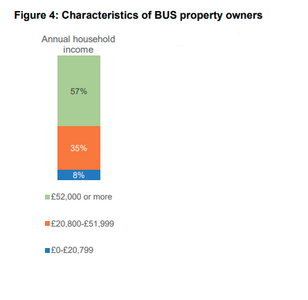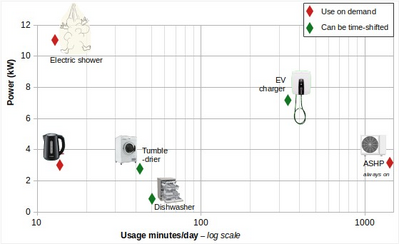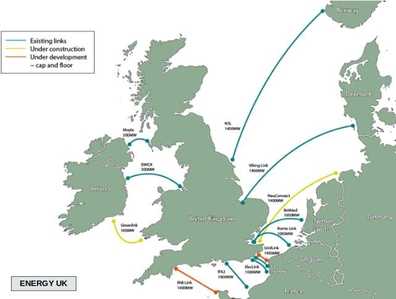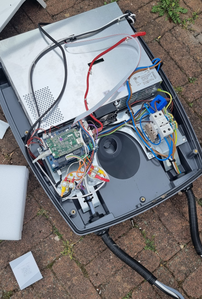Posted by: @jamespaCompletely agree. To my mind this is not worth the effort of engaging with such a solution, either
- we will abandon net zero altogether, which seems not improbable. This will have absolutely disastrous consequences IMHO, not just in terms of the climate but in terms of our increased dependence on despot, and increasingly desperate, states for our energy supplies whilst China and progressive countries enjoy abundant essentially free energy
- the problem will be solved another more sane way, or
- it wont be solved, there will be blackouts, the rich will protect themselves with batteries and the poor will shiver
Based on what @transparent is telling us my bet is on (1) or (3)
(3) also implies/includes (1), and (3) is already happening (using household income of BUS heat pump grants as a proxy):
Source:
Not perfect, bands too wide (how many in the middle band are near the top of the band?) but the best I could find. Seems like no one really wants to look into what is really a rather important question.
Midea 14kW (for now...) ASHP heating both building and DHW
Whilst I suspect you are correct I suppose the possible fault with this interesting analysis is that less well off people will be eligible for ECO4 which, so far as I am aware, excludes BUS.
4kW peak of solar PV since 2011; EV and a 1930s house which has been partially renovated to improve its efficiency. 7kW Vaillant heat pump.
Posted by: @jamespathe basic question remains, why has a solution based on home storage been discarded?
If a group representing the energy sector met with BEIS back in 2021/22 as the catalyst for the SSES Programme, then Storage wouldn't be on the agenda.
Firstly, companies holding operator licences from Ofgem are prohibited from owning or controlling generation or storage assets.
Secondly, foremost in HMG's mind at the time was the need to ramp up the number of heat-pump installations.
It was unlikely that anyone pointed out to BEIS where heat-pumps sat on the spread of home appliances which contributed most to high demand:
Two other things occur to me:
1: Tepeo's ZEB could readily be offered in a version which would make it eligible to take part in CLF.
However, it only consumes 25w when it's simply dispatching existing heat into the dwelling.
Consumers would already be re-charging it from the grid during low-cost periods via a ToU Tariff.
The demand-reduction would be extremely small, whilst participants would still receive compensation paid into their energy account.
How long do you think it would take for a "cheat kit" design to be offered online, whereby people could hot-wire the ZEB and supply it with the 25W from
a small battery and an inverter whilst the Load Controller still believed it to have been "switched off"?
2: Since SSES will increase bills for the consumers who do not take part in the CLF programme,
it's a very attractive target for a General Election candidate to tackle.
An incoming government could axe CLF at a stroke, and claim that they've decreased consumer energy bills!
Given that risk, how do you think this programme will be viewed by existing heat-pump manufacturers?
How likely is it that they'd be prepared to design an ASHP which can be certified as an Energy Smart Appliance (ESA) for installation in UK?
Save energy... recycle electrons!
Posted by: @jamespaWhilst I suspect you are correct I suppose the possible fault with this interesting analysis is that less well off people will be eligible for ECO4 which, so far as I am aware, excludes BUS.
I think you are probably right, it's either BUS or ECO4. Finding the ECO4 heat pump numbers is not straight forward, it may be around 20,000 in total, compared to around 50,000 BUS heat pump grants (again, in total). It really is remarkable how well the government manage to hide basics numbers, especially when they might be potentially embarrassing...
Midea 14kW (for now...) ASHP heating both building and DHW
Posted by: @transparentSince SSES will increase bills for the consumers who do not take part in the CLF programme,
it's a very attractive target for a General Election candidate to tackle.
An incoming government could axe CLF at a stroke, and claim that they've decreased consumer energy bills!
Indeed, all the more so as it is a clear example of robbing poor Peter to pay rich Paul. It is totally unacceptable in any shape or form.
Midea 14kW (for now...) ASHP heating both building and DHW
Posted by: @cathoderayPosted by: @jamespaWhilst I suspect you are correct I suppose the possible fault with this interesting analysis is that less well off people will be eligible for ECO4 which, so far as I am aware, excludes BUS.
I think you are probably right, it's either BUS or ECO4. Finding the ECO4 heat pump numbers is not straight forward, it may be around 20,000 in total, compared to around 50,000 BUS heat pump grants (again, in total). It really is remarkable how well the government manage to hide basics numbers, especially when they might be potentially embarrassing...
The following source indicates 19,416 ASHPs had been installed under ECO4 at the half way point of the scheme, in May 2024
Perhaps more concerning, is that more than twice the number of boilers (45,138) were installed or upgraded under the same scheme.
Samsung 12kW gen6 ASHP with 50L volumiser and all new large radiators. 7.2kWp solar (south facing), Tesla PW3 (13.5kW)
Solar generation completely offsets ASHP usage annually. We no longer burn ~1600L of kerosene annually.
Posted by: @old_scientistThe following source indicates 19,416 ASHPs had been installed under ECO4 at the half way point of the scheme, in May 2024
Yes, that was the source I used. Unusually I didn't mention the source, not sure why! Perhaps because it had a rather amateur air about it. Also, although the page says it was updated in July this year, the data only goes up to May 2024. This is what I meant about it not being easy to get (up to date) data. I'm not sure whether both are UK (all four nations) or subsets. All very tedious having to tease out the detail.
The total BUS + ECO4 number is also very low, when set against the governments 600,000 heat pump installations a year. According to the trade body, the Heat Pump Association, just under 100,000 heat pumps passed the factory gate in 2024 (their definition of a sale, I hope they didn't take them round the back and wheel them out again!), but it looks like they used some whatiffery (aka modelling) to get that number, which if true suggests a sizeable number of heat pumps (30,000+, the BUS and ECO4 numbers cover longer periods, it looks like the BUS 2024-25 number was only 25,000, ) are installed without grant assistance. How plausible that is I am not sure.
A bit later: frustrated at the lack of data, I kept on digging and at last managed to find something a bit more definitive: Heat pump deployment quarterly statistics United Kingdom: 2025 Q2 (official statistics in development)! This is a spreadsheet produced by DESNZ (a official government department still in development) and it looks like it has reasonably sound data, for all the UK. It can be downloaded here.
In summary, for 2024 (latest full calendar year) (2025 is still in development), there were a total of 43,878 grant supported heat pump installations, of which 22,657 were done under the BUS, and 17,219 were done under the ECO (presumably most of not all ECO4), the remainder made of of much smaller schemes. That makes the Heat Pump Association's numbers look even more suspect - unless I am missing something fairly major.
Midea 14kW (for now...) ASHP heating both building and DHW
I've just tried to speed-read the 3 pages of posts since I last checked in here. A fascinating discussion, some of which has been discussed internally at tepeo. A couple of points from my personal perspective:
1. I think heat pump technology is a victim of its own success, in the context of flexibility. As an efficient method of heating it can't provide much flex by itself, as it doesn't put a big load on the grid. And a good heat pump installation won't have much spare capacity in the depths of winter. This makes the scenario of turning off heat pumps in times of high grid loads quite unpalatable, due to the impact on comfort of the long recovery periods, and the low perceived benefit to the grid. (But you could restrict their power draw to a percentage of maximum, retain comfort, and still reap some grid load benefits at scale.)
2. Avoiding investment in upgrading infrastructure implies load levelling primarily with storage, and secondarily with usage. It seems likely that electrifying all the things will at some point mean generating more electricity. But if we optimise how we use our existing infrastructure we can delay and in some cases avoid a massive overhaul of all of it, and be better prepared for when we do increase its capacity. As long as the incentives offered for levelling do not exceed the cost of infrastructure upgrades it won't be putting a burden on energy bills.
3. Pairing a heat pump with a battery storage system is a great combination. The heat pump can keep trucking all day long so that comfort levels are unaffected, and its power consumption is decoupled from the grid by the battery. The battery can then be charged at times that are best for the grid, be that turning down charging during times of high demand, or turning up charging during times of high supply.
4. The ZEB has a charging algorithm called Smart Charging that attempts to minimise thermal losses by only charging the dry core with the heat that is going to be required. Smart Charging builds a historical model of the house's heat demand, and uses a prediction of future heat demand (based on a weather forecast) and the future tariff pricing to optimise when charging happens. Incidentally Smart Charging also uses NESO's prediction of the grid's future carbon intensity, and customer's can choose whether to cost optimise charging, carbon optimise charging, or a blend of the two. Carbon optimised is not a popular choice with ZEB customers.
5. The historical available capacity of the local infrastructure could be fed into Smart Charging as a 3rd signal, alongside tariff price and carbon intensity. Smart Charging would then prioritise charging at times of day when the local infrastructure had the most available capacity. This is in effect a flexibility signal, and something that tepeo is working on with flexibility service providers.
6. A typical ZEB installation has running costs of around £750 a year. I'd love to see a situation where running costs for the homeowner are reduced through revenues generated providing flex. The homeowner would not even be aware of what the ZEB was doing, just moving charging around to times when the flex benefit is highest, while still having enough stored heat to meet the demand.
I have long been of the opinion that local storage is a vital part of any solution to grid overload, and now that @transparent has told us that the 11kV capacity is the principal issue, but that it is already sufficient when averaged over 24hrs, it seems obvious to me that this must be factored in.
As you also say the capacity for a well designed heat pump system to recover from a lengthy switch off is rather limited, and anyone proposing a forced interruption of an hour or more, and certainly for the three hour peak period, will need to deal with disgruntled householders, who will likely experience a cold house for perhaps 12 hrs or more while the system recovers, as well as increased energy consumption because of the reduced COP during the recovery period when it will normally be colder outside. There may even be the possibility that the heat pump wont recover at all - suppose it is turned off just before a defrost cycle when the fins are fully iced up. When it switches back on there is no hot water left in the system to melt the ice, so it may well not restart. I would be interested to hear how NESO propose to deal with that scenario should it occur.
EVs on the other hand seem to me to offer much more promising prospects. Current EV chargers are typically 7kW single phase. By contrast a typical largeish, not particularly well insulated house (like my 200sq m 1930s property) may require a 7kW heat pump which, running at a COP of say 2.5, consumes only 2.8kW, ie much less than an EV charger. Charging of EVs is rarely time critical to the extent that heating is, so if we want to look at 'forced', or strongly incentivised, switch off we should surely focus on EVs not heat pumps.
To me the focus should be on incentivising (or forcing) each house to manage its own maximum load (at peak times), enforced if necessary through the smart meter or another interrupter and incentivised through pricing. This then gives the householder flexibility to manage in the way that suits them. Of course some technology will be needed, but this isn't at all difficult and the market will surely oblige with solutions; by way of proof many EV chargers already have the capability to 'turn down' if the load on the main incomer to the house exceeds a pre set value, if we were to build on this the whole thing could be managed locally to each house with almost no need for security measures.
Then we need to consider V2G. This will surely become commonplace during the next few years and so the majority of EVs, once EVs (and for that matter heat pumps) reach a high level of deployment, are likely to be fitted with it. Again, with the right incentives, this could be used to balance load by releasing energy back to the local grid. The 64kWh battery of a typical EV is HUGE by comparison to a typical domestic storage battery, so there is plenty of capacity, and most EVs, like most fossil burners, sit on the drive for 12hrs per day specifically including the peak hours (obviously - that's why they are peak!)
It seems to me that idea of forcibly turning off heat pumps from a central location seems to me fundamentally flawed, and unlikely to see the light of day because of likely political unpalatability once the consequences are made public, lack of practicality versus obvious alternatives, and the enormous security risk to critical infrastructure.
Of course I do accept that there may be factors of which I am unaware which change the analysis, and it would be good to understand these. It will also be necessary for the public to understand them if the idea is to gain acceptability. I hope NESO staff are reading this thread and at least think about some of the comments that people (including me) have made; If they are reading perhaps someone would like to take part in the discussion or at least explain why turning off heat pumps is considered the best solution!
4kW peak of solar PV since 2011; EV and a 1930s house which has been partially renovated to improve its efficiency. 7kW Vaillant heat pump.
Posted by: @wullyif we optimise how we use our existing infrastructure we can delay and in some cases avoid a massive overhaul of all of it
The energy sector doesn't want you raising that idea.
The present narrative is that we need massive infrastructure upgrades to meet Net Zero.
That means lots of work for the Transmission and Distribution Operators, so they ask Ofgem to approve significant bill increases.
Almost all of the infrastructure upgrades we hear about are at the higher voltages.
They're headline grabbing, but have little consequence for us ordinary consumers.
They're certainly not bringing down prices!
If the mass of solar-farms and wind-turbine arrays are connected at the 11kV & 33kV levels, then they're already close to where we want the electricity!
The reason that hundreds of new solar-farms are seeking planning permission close to Bulk Supply Points and Grid Supply Points is because the owners
aren't wanting to supply the local population. They want access to the marine interconnectors in order to 'play' the European market.
Posted by: @wullyThe historical available capacity of the local infrastructure could be fed into Smart Charging as a 3rd signal, alongside tariff price and carbon intensity. Smart Charging would then prioritise charging at times of day when the local infrastructure had the most available capacity. This is in effect a flexibility signal, and something that tepeo is working on with flexibility service providers.
You have flexibility providers with data on the available cable capacity at the 11kV level?
I would be very surprised. 🤨
It's just far too expensive to monitor the lower voltage levels.
Apart from the cost of the monitoring equipment itself, there's also the radio communications channels and data storage/sorting.
That's why the Ofgem-funded OpenLV Project (2018) only put 86 monitors into local substations, and only licensed for 12-months!
There are 230,000 ground-mounted local substations and 320,000 pole-mounted.
Only a few hundred have ever been monitored, most of those for specific projects.
The Primary Substations are mostly un-manned, but they do have alarm/fault monitors of varying types.
Those supply live data to the DNO's area engineers.
Very few DNO Engineers know the max/min voltage levels at the far end of the 11kV and LV supplies on their own patch.
If there's ever a need to know during a fault-finding visit, then they use a hydraulic platform and a voltmeter.
But they're not required to keep any records of what they find after a fault is fixed.
Go and ask the DNO Engineers working in your area!
When I'm suggesting a demand-reduction/leveling system in this topic, I mean a strategy which does not require scattering monitors on all the cable routes!
It has to be a technical/mathematical approach,
with some AI thrown in to verify that the model is adequate for the purpose. 🙂
Save energy... recycle electrons!
Posted by: @jamespaThen we need to consider V2G. This will surely become commonplace during the next few years
Sadly not so.
The V2G Trial undertaken by OVO with chargers built by Indra Renewable Technologies commenced in 2018.
The software was written by Kaluza.
Indra and Kaluza are part of the OVO Group.
They could only accept Nissan EV's which had CHAdeMO connectors (the LEAF and its van derivative).
The CHAdeMO has bi-directional DC charging built-in as standard.
Indra built around 460 'prototypes' using a modular approach.
The money ran out before the 1000 sites they'd aimed for.
This OVO Sciurus Project was independently audited, but was only 'viable' if you didn't count the energy losses.
Most EVs use a CCS connector, which has no bi-directional capability.
The two DC pins at the bottom are only for rapid-charging.
Save energy... recycle electrons!
Posted by: @jamespaThen we need to consider V2G. This will surely become commonplace during the next few years
Sadly not so.
Why not?
Octopus is offering v2g with a BYD lease vehicle. If BYD have it then others will surely follow suit. V2H is presumably as useful for local (IE per house) balancing.
4kW peak of solar PV since 2011; EV and a 1930s house which has been partially renovated to improve its efficiency. 7kW Vaillant heat pump.
- 26 Forums
- 2,342 Topics
- 53 K Posts
- 260 Online
- 6,000 Members
Join Us!
Worth Watching
Latest Posts
-

RE: Are We Sleepwalking Into Another Race to the Bottom?
…otherwise known as “hive got news for you”. And don’...
By Majordennisbloodnok , 7 minutes ago
-
RE: Configuring third party dongle for Ecodan local control
Logically, I'll fall into that category so the natural ...
By Sheriff Fatman , 33 minutes ago
-

RE: Controlling Daikin Altherma via P1P2 and Home Assistant
I haven’t got a Daikin but I have been having some fun ...
By Majordennisbloodnok , 1 hour ago
-

RE: Setback savings - fact or fiction?
@robs — thanks again for your detailed comments. Some r...
By cathodeRay , 3 hours ago
-
RE: Free Ecoheat Heat Pump Install
I don't mind thread drift, it's how conversation natura...
By Deltona , 5 hours ago
-

RE: A Smarter Smart Controller from Homely?
@papahuhu I hope you get a swift resolution. Regards, T...
By Toodles , 7 hours ago
-

RE: Poll for Time of Use, tariffs, technology
That’s fine by me too Major, I feel it is a sad reflect...
By Toodles , 8 hours ago
-

Bingo. Sometimes a judiciously placed size 10 bovver bo...
By Majordennisbloodnok , 9 hours ago
-
RE: Mitsubishi Ecodan 11.2kW heat pump with low COP
@ciocoiu-alexandru I can't provide the same level of di...
By Sheriff Fatman , 9 hours ago
-
RE: Octopus Cosy Heat Pump Owners & Discussion Thread
Recently had my follow up with octopus for the vibratio...
By swwils , 10 hours ago
-

The three technical issues I'm considering are: BMS...
By Transparent , 11 hours ago
-
RE: LiFePO4 lithium battery fires and explosions
@transparent Your post may fit better in th...
By Batpred , 12 hours ago
-

RE: British Gas vs Octopus Energy vs Heat Geek vs EDF vs Aira vs OVO vs EON.Next vs Boxt
@jamespawhite, if you could be bothered, you could also...
By Mars , 13 hours ago
-
RE: Commencing on an ASHP Installation Process
I've got a bit of time to draft something today, so the...
By Sheriff Fatman , 1 day ago
-
RE: Help with heat pump sizing
@amin I dont think materially relative to t...
By JamesPa , 1 day ago
-

@majordennisbloodnok I have decided to take the plunge....
By TechnoGeek , 1 day ago
-
RE: Different dT on each radiator?
I cant sorry. Its based on some calculations I did fro...
By JamesPa , 2 days ago
-
RE: Help me keep the faith with my air source heat pump installation
@simonf thats interesting as I’ve noticed my flow and r...
By AdamK , 2 days ago








